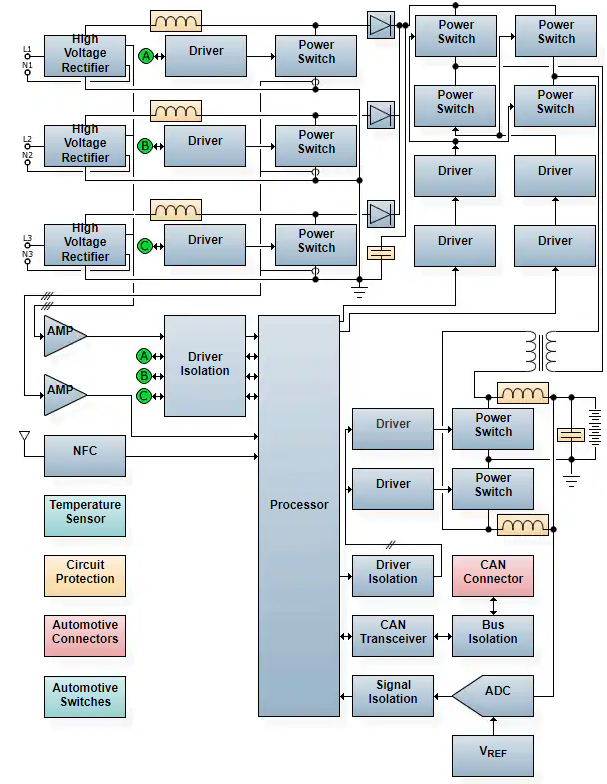Automotive
Automotive Application - HEV Battery Charger
EV and PHEV (Plug-in Hybrid Electrical Vehicle) systems push the envelope of vehicle electrification by allowing high voltage battery banks to recharge from the mains. A high voltage charger converts electrical power from AC to DC, and controls the power flow to the high voltage battery. Electronics on board the car transform the wall power into the proper form to charge the battery. The power levels for these chargers range from 3 to 10 kW, and therefore require a front-end PFC circuit. There are 3 levels of charging that are classified by peak power capacity. Level 1 charging enables charging from any standard electrical plug, which in the United States is 120V and limited in peak amperage draw (8 - 15 amps) by local circuit breakers. Level 1 chargers are portable converters that may be placed in the trunk for use anywhere a standard outlet can be found. Charging can take up to 22 hours for a fully depleted battery. At Level 1 charging, a user might be inclined to plug in every time a charger is available, with cumulative partial charges extending driving range on an ongoing basis.
Level 2 charging supplies 240V power that in the U.S. typically feeds an electric clothes dryer or kitchen oven. Level 2 charging can take from 4 – 8 hours or more, depending on the battery energy level when the car is plugged in, and charge rating capacity of the vehicle model. Presently, electronics on board the car convert wall power to charge the battery, and each car model has its own power capacity rating, which affects charging time. Level 3 charging is dedicated to the high current draw that an electric vehicle battery bank would need to make an EV or PHEV practical for everyday use with rapid charging times of 2 hours. (However, charging times are always limited by the rate of power feed that the vehicle model is designed to take.) For comparison purposes, power ratings for EV/PHEV charging ranges from 3.3kW, 6.6kW, and 16.8kW at the present. Lower charging and operating temperatures seem to extend the capacity-life of the batteries. Faster charging times correlate to higher power and higher temperatures with present battery technology. But as technology evolves, charging rates above 19kW, will become standard and significantly reduce charging times. It is guaranteed that technology will outpace infrastructure and legislation.
In the U.S., taxation for roads comes via national gasoline sales taxes that are collected at the pump. This taxation is avoided by early adopters of EVs and PHEVs until legislation dictates standards. Standardization of the battery charging protocol is underway in the U.S., but not yet fixed. Standards encompass the plug/connector, communication link, whether charging will be on-board or external to the car, and at what physical point charging will be monitored in relation to the smart grid. Who and how electrical billing will happen (exclusively for charging cars) is yet to be determined, and will likely be a de facto standard formed where technology presents the most convenience.
HEV Battery Charger Block Diagram

This design is for reference only. The design, as well as the products suggested, has not been tested for compatibility or interoperability.